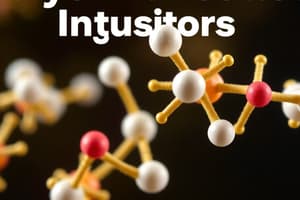Podcast
Questions and Answers
What is the correct function of Edrophonium (Enlon®) in diagnosing myasthenia gravis?
What is the correct function of Edrophonium (Enlon®) in diagnosing myasthenia gravis?
Why is Edrophonium not recommended for maintenance therapy in myasthenia gravis?
Why is Edrophonium not recommended for maintenance therapy in myasthenia gravis?
Which statement about the pharmacokinetics of Edrophonium is correct?
Which statement about the pharmacokinetics of Edrophonium is correct?
Study Notes
Indirect-Acting (Anticholinestrase)
- Inhibit acetylcholinesterase enzyme, increasing acetylcholine (ACh) levels
Reversible Anticholinesterase (AChE Inhibitors)
- Bind to the active center of acetylcholinesterase (AChE) enzyme, inactivating it through conformational change
- Indirectly stimulate both nicotinic and muscarinic acetylcholine receptors
Edrophonium (Enlon®, Enlon-Plus®)
- A short-acting AChE inhibitor
- Quaternary amine, so actions are limited to the periphery (does not pass the blood-brain barrier)
- Rapidly absorbed and has a short duration of action due to rapid renal elimination
Pharmacokinetics
- Onset of action: IV (30-60 seconds), IM (2-10 minutes)
- Duration of action: IV (5-10 minutes), IM (5-30 minutes)
- Half-life: 7-12 minutes
- Elimination time: 33-110 minutes
Uses
- Diagnosis of myasthenia gravis: IV injection of edrophonium leads to rapid increase in muscle strength
- Antidote for curare or curare-like agents (neuromuscular blockers) to reverse the effects of certain medications used during surgical procedures
- Not recommended for maintenance therapy in myasthenia gravis due to short duration of action
- Was previously used to terminate supraventricular tachycardia, but has been replaced by other antiarrhythmic agents
Studying That Suits You
Use AI to generate personalized quizzes and flashcards to suit your learning preferences.
Description
Learn about indirect-acting anticholinesterase, reversible AChE inhibitors, and their mechanisms of action on acetylcholinesterase enzyme and acetylcholine receptors.




